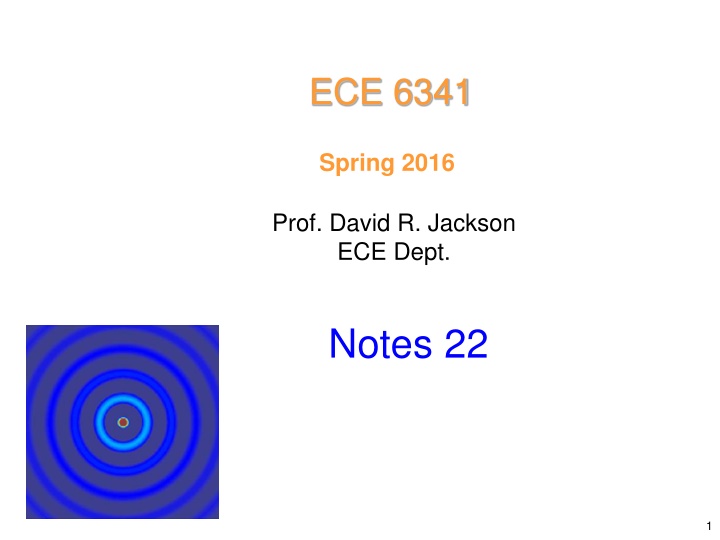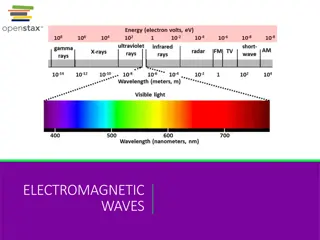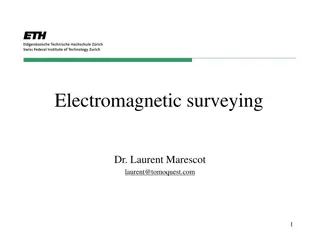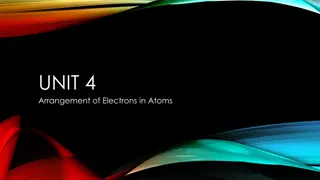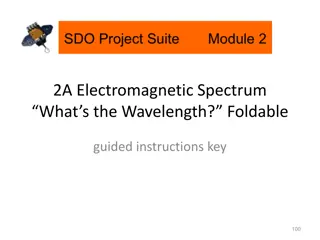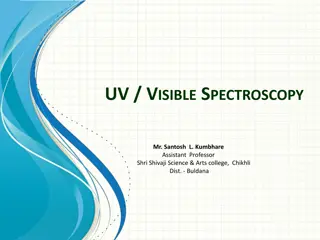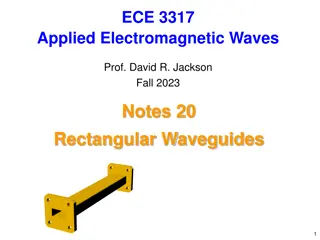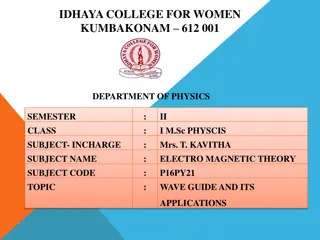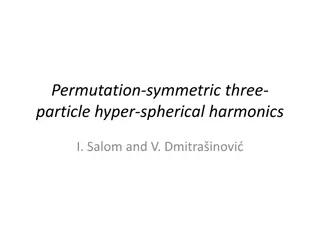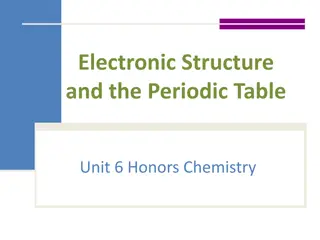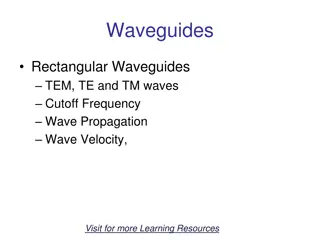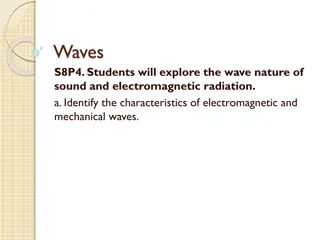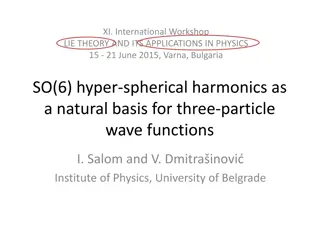Analysis of Spherical Resonator Modes in Electromagnetic Field
Characteristics of spherical resonator modes in terms of potential distributions and oscillations. Understand the implications of TM modes and derive relationships for optimal resonance. Investigate the behavior of field components and the required conditions for non-trivial solutions. An examination of different values for resonator parameters provides insights into mode selection and practical applications.
Uploaded on Feb 19, 2025 | 2 Views
Download Presentation

Please find below an Image/Link to download the presentation.
The content on the website is provided AS IS for your information and personal use only. It may not be sold, licensed, or shared on other websites without obtaining consent from the author.If you encounter any issues during the download, it is possible that the publisher has removed the file from their server.
You are allowed to download the files provided on this website for personal or commercial use, subject to the condition that they are used lawfully. All files are the property of their respective owners.
The content on the website is provided AS IS for your information and personal use only. It may not be sold, licensed, or shared on other websites without obtaining consent from the author.
E N D
Presentation Transcript
ECE 6341 Spring 2016 Prof. David R. Jackson ECE Dept. Notes 22 1
Summary of Potentials ( ( ) ) ( ( ) ) m n cos cos P m = A F ( ) r B kr n m n sin m cos Q r ( ) x ( ) n B x = = ( ) x b x x B 1/2 + n n 2 x ( ) ( ) ( )( ) ( )( ) J Y x x m n w ( ) x = B In general, 1 H x 2 H x 2
Spherical Resonator z PEC (hollow) a y x TMrmodes ( ) ( ) ( ) ( ) , , = m cos cos A r J kr P m r n n ( ) = = integer included 360 w m ( ) = m n = No finite field at 0, Q ( ) = = integer finite field at included n = No ( 0) Y r n 3
Spherical Resonator (cont.) = = 0 E r a = 0 E r a = 2 1 A = E r j r r r 2 1 1 A = E r j sin r 4
Spherical Resonator (cont.) Hence we choose A r = 0 r = r a ( ) = 0 n J ka Therefore ( ) np = 0 J u Denote n ( ) x J np = th u p root of n 5
Spherical Resonator (cont.) ( ) x J np = th u p root of n ( ) u = x n J x np x = = 1 2 p p 6
Spherical Resonator (cont.) u = ka np ( ) np = TM r 2 f a u Then np u a = TM f so r 2 rf m Note: is independent of For a non-trivial solution: m n 7
Spherical Resonator (cont.) u values np 1 2 3 4 5 6 p \ n 1 2.744 3.870 4.973 6.062 7.140 8.211 2 6.117 7.443 8.722 9.968 11.189 12.391 3 9.317 10.713 12.064 13.380 14.670 15.939 4 12.486 13.921 15.314 16.674 18.009 19.321 8
Spherical Resonator (cont.) TMmnp mode: r a ( ) ( ) ( ) np , , = m cos cos A r J u P m r n n Index m: controls oscillations in Index n: controls oscillations in Index p: controls oscillations in r 9
Spherical Resonator (cont.) Note on n=0: If n = 0, we must also have m = 0 (m n). The TM00p mode has a trivial field. Proof: 0 ( ) J x ) = 0( ) 1 P x = = cos(0 ) 1 0 cos x ( ) ( , , = cos rA r kr 2 1 = + = 2 0 r E k 2 j r 2 1 = = 0 E r r j 2 1 r = = 0 E sin j r 10
Spherical Resonator (cont.) ( ) ( ) ( ) = m cos cos F J kr P m TEr : r n n 1 sin F F = E r r 1 = E r r So choose = 0 F = r r a ( ) ( ) x J = = th u p 0 J u root of Denote np n n np 11
Spherical Resonator (cont.) ( ) x J = th u p root of np n ( ) = n J x x u np x = = 1 2 p p 12
Spherical Resonator (cont.) values u np 1 2 3 4 5 6 p \ n 1 4.493 5.763 6.988 8.163 9.356 10.513 2 7.725 9.095 10.417 11.705 12.967 14.207 3 10.904 12.323 13.698 15.050 16.35 17.648 4 14.066 15.515 16.924 18.301 19.653 20.983 13
Spherical Resonator (cont.) = ka u np Then ( ) = TE r 2 f a u np so u a np = TE f r 2 ( ) x = ( ) n B x u x+ = = ( ) x b x x B Note: since 1/2, np n p 1/2 + n n 2 x Here we are using the notation from the cylindrical chapter. 14
Spherical Resonator (cont.) Mode ordering (by cutoff frequency) Notation: (m, n, p) m n ( ) ( ) ( ) , , , , , , TM TM TM TM TM TE TE 011 = 111 021 121 = 221 011 = 111 = = = 1, 1 2, 1 1, 1 n p n p n p u = u = u = 2.744 3.870 4.493 11 21 11 15
Hollow Conical PEC Horn z Region of interest = 1 y x TMr ( ) ( ) = (2) m cos cos ( ) rA m P H kr Note: = m (1) P m ( 1) P 16
Conical Horn (cont.) 2 1 = + 2 E k A r r j 2 r = 0 = 1 so = 0 rA = 1 Hence = m (cos ) 0 P Note: The integer index m is arbitrary. 1 (This is a transcendental equation for .) 17
Conical Horn (cont.) Plot of function: m = (cos ) P C mp (The superscript C stands for cone. ) 1 = = 1 2 p p ( ) ( ) = (2) C mp m cos cos ( ) rA m P H kr C mp 18
Conical Horn (cont.) Note: An upside-down horn would use z cos cos ( ) ( ) = (2) m cos cos ( ) rA m P H kr y mp mp x = 1 Alternatively, ( ) = (2) n m cos (cos ) ( ) A m A P H kr r n n n m = Region of interest 19
Conical Horn (cont.) TEr rF = 0 = 1 m (cos ) P = C mp (The superscript C stands for cone. ) 1 = = 1 2 p p ( ) ( ) = (2) C mp m sin cos ( ) rF m P H kr C mp 20
Conical Horn (cont.) Feeding a conical horn from the TE11 mode of circular waveguide This can be approximately modeled as the TE11 mode of the spherical conical horn. ( )( 11 ) 1 C = (2) C sin cos ( ) rF P H kr 11 Circular waveguide (TE11 mode) z 21
Wedge z 1 Source Region of interest: 0 1 x Notes: ( ) integer not included 360 w ( ) = = integer axis included n z 22
Wedge (cont.) TMr : ( ) ( ) kr = (2) n w sin (cos ) A w P H r n = = = 0 @ 0, r A w m 1 1 so m = = = , 1,2 w w m m 1 ( ) ( ) kr = w (2) n sin (cos ) A w P H m r m n 23
Wedge (cont.) TEr : ( ) ( ) = (2) n w cos (cos ) F w P H kr r n r F r = = = 0 @ 0, w m 1 1 so m = = = , 1,2 w w m m 1 ( ) ( ) = w (2) n cos (cos ) A w P H kr m r m n 24
Spherical Horn z The bottom of the horn is on the z= 0 plane. 1 = 1 y = 0 = 1 = /2 x integer integer w ( ) axis not included z 25
Spherical Horn (cont.) TMr : ( ) kr ( ) ( ) ( ) = + (2) w w sin cos cos rA H w P AP 2 1 = + 2 E k A r r 2 j r = = 0 @ 0, rA 1 w = sin 0 1 so m = = = , 1,2 w w m m 1 26
Spherical Horn (cont.) ( ) 0 ( ) 0 + = w w = 0 P AP / 2: m m = 1 A ( ) ( ) = w w = cos cos 0 P P 1: m m 1 1 = H mp (must be found numerically) 27
Spherical Horn (cont.) Plot of function: ( ) ( ) w w cos cos P P m m 1 1 = H mp (The superscript H stands for horn. ) = = 1 2 p p 28
Spherical Horn (cont.) TMmp mode: ( ) kr ( ) ( ) ( ) = w w (2) H mp sin cos cos A H w P P m m r m H mp H mp z 1 = 1 y = 0 = 1 = /2 x 29
Spherical Horn (cont.) TEr : ( ) ( ) ( ) ( ) = + (2) w w cos cos cos rF H kr w P AP 2 1 = + 2 H k F r r 2 j r F = = 0 @ 0, r 1 w = sin 0 1 so m = = = , 1,2 w w m m 1 30
Spherical Horn (cont.) ( ) ( ) 0 ( ) 0 = w w sin 0 = P AP / 2: m m = /2 A= + 1 ( ) ( ) = + = w w 1: cos cos 0 P P m m 1 1 = H mp (must be found numerically) 31
Spherical Horn (cont.) Plot of function: ( ) ( ) + w w cos cos P P m m 1 1 = H mp (The superscript H stands for horn. ) = = 1 2 p p 32
Spherical Horn (cont.) TEmp mode: ( ) ( ) ( ) ( ) = + w w (2) H mp cos cos cos F H kr w P P m m r m H mp H mp z 1 = 1 y = 0 = 1 = /2 x 33
